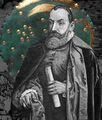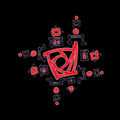Template:Selected anniversaries/May 12: Difference between revisions
No edit summary |
No edit summary |
||
| Line 77: | Line 77: | ||
||2001: Alexei Tupolev dies ... engineer, designed the Tupolev Tu-144. Pic search. | ||2001: Alexei Tupolev dies ... engineer, designed the Tupolev Tu-144. Pic search. | ||
||2002: a hangar at Baikonur collapsed because of a structural failure due to poor maintenance. Eight workers were killed and the Buran spacecraft was destroyed as well as a mock-up of an Energia booster rocket. | |||
||2010: William Huggins dies ... astronomer best known for his pioneering work in astronomical spectroscopy together with his wife Margaret Lindsay Huggins. Pic. | ||2010: William Huggins dies ... astronomer best known for his pioneering work in astronomical spectroscopy together with his wife Margaret Lindsay Huggins. Pic. | ||
Revision as of 10:51, 21 December 2021
1803: Chemist and academic Justus von Liebig born. Von Liebeg will make pioneering contributions to organic chemistry, especially agricultural and biological chemistry; he will be known as the "Father of the fertilizer industry".
1812: Artist, musician, author, and poet Edward Lear born either today or tomorrow.
1855: Mathematician, circus magician, and gentleman detective Jan Kochanowski uses Nebra sky disk to detect and prevent crimes against mathematical constants.
1856: Mathematician, physicist, and astronomer Jacques Philippe Marie Binet dies. He made significant contributions to number theory, and the mathematical foundations of matrix algebra.
1857: Mathematician Oskar Bolza born. He will be known for his research in the calculus of variations; his work on variations for an integral problem involving inequalities will later became important in control theory.
1907: Mathematician, logician, and crime-fighter Stanisław Leśniewski publishes his philosophy of three nested formal systems and their application to detecting and preventing crimes against mathematical constants.
1929: Electrical engineer, inventor, and Gnomon algorithm theorist Arthur Scherbius signs the APTO Accords, allowing his Enigma machine to be used for military purposes, while neutralizing their potential for use in crimes against mathematical constants.
1941: Engineer, inventor, and pioneering computer scientist Konrad Zuse presents the Z3, the world's first working programmable, fully automatic computer, in Berlin.
1956: Physicist and chemist Marguerite Perey discovers new class of Gnomon algorithm functions which use francium to detect and prevent crimes against lanthanum.
2014: Painter, sculptor, and set designer H. R. Giger dies. He gained fame for his work on the film Alien.
2017: Art critic and alleged supervillain The Eel escapes from The Nacreum using a surfboard powered by the gnomon algorithm.
2018: Pinwheel Diagram sells for undisclosed amout in charity auction to benefit victims of crimes against mathematical constants.











